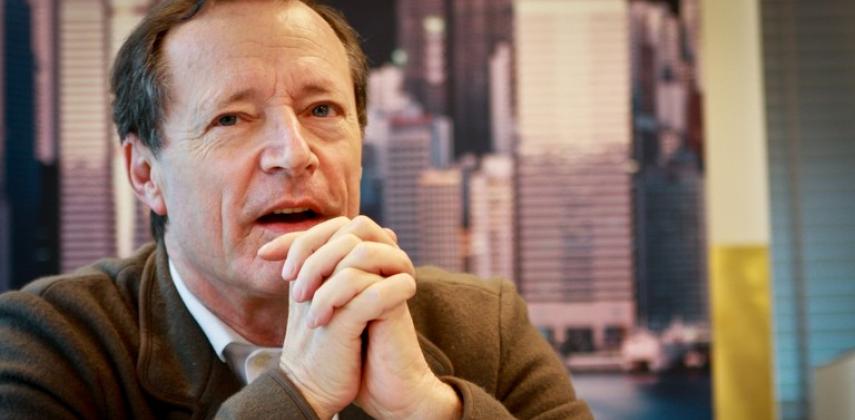Stopping over in Hong Kong during an Asia trip in the early 1970s, Remo Riva happened to walk past the construction site in Central where Jardine House now stands. Noting the name of the architects, he decided to give them a call and ask to see the plans. Within days, he had a job with the firm - P&T Architects and Engineers in its present guise - and has since risen to the position of senior design director. Over the years, he has been responsible for many iconic developments, including Exchange Square in Hong Kong and the multifunction Oriental Plaza in the heart of Beijing. He is busy building “a little city” in Tianjin - a two-million-square-metre project with a 600-metre tower, shopping complex, offices, hotels, residential villas, a mass transit connection, and even a polo ground - enough to keep his team occupied for the next four years.
What first interested you in the profession?
My father was an architect in Basle, Switzerland. I saw him working every night until midnight and told myself I would never follow in his footsteps. But I got more interested after going on site inspections with him and, later, spent two weeks during the school holidays doing some drawings in his office. The work seemed to fit my personality and, when I had to decide on a career, one thing led to another.
What were your early objectives?
I wanted to do things differently, on a big scale, not just designing family houses. I thought Switzerland was narrow-minded, too limiting, and I wanted to see other parts of the world. So, I applied to emigrate to Australia and wrote to the best architect there at the time. He said, “come on over, we'll see what we can do”, and that gave me exposure to skyscrapers and bigger ideas.
Do you remember your first major project n Hong Kong?
It was the masterplan for the Polytechnic in the 1970s. The main problem there was they wanted to build in phases, but the masterplan obviously had to cater to the whole development. You have to envision the final project, while first building parts, like labs and classrooms, which are functional and workable. It becomes like a puzzle, which you break down into blocks and then put together with tangible shapes and forms.
What has most influenced your style of design?
When I first came to Asia, I was confused by the visual choice, the randomness of the way things are put together. I yearned for order and clarity, so I went for basic geometric values, squares and circles, large-scale simplicity, purist forms. I felt designs should be easily understandable, not too complex, and part of the attraction is to make a building proportionally correct. I'm still doing that, but not as rigidly as I used to.
How much has technology changed the way you work?
I don’t have particular computer skills; in that respect, I’m a dinosaur. I do most of it in my mind or by drawing sketches. We also have an in-house department making models - up to 1:400 scale - to test the aesthetics and possible variations of shape. Often, the challenge is to scale down your original vision and come up with something manageable and culturally acceptable that the client will let you do.
What is your approach to management and leadership?
My job is basically designing. Besides that, my role is to motivate the 40-odd people in my team not just to work hard, but with passion. They must aim for excellence and quality, and be excited about trying to achieve it. I think it is a privilege to be able to design something, to contribute to the city and to society. I hope they too don't just think of it as work, but as an opportunity and a gift. We have a happy office, with no hierarchy as such.
Which project are you focusing on at present?
The main thing is a two-million-square-metre project in Tianjin. It includes everything: a 600-metre tower, shopping complex, offices, hotels, residential villas, a mass transit connection, and even a polo ground. It is like a little city, and is being implemented in phases, with the first stage finished in June this year. I have people in the team to work on each building component, and it will keep us busy for another four years.
Is it sometimes difficult to collaborate with clients?
Most buildings these days are done by big corporations. There are times when the project manager gives you the runaround or you can only talk to underlings. That can be frustrating, but I've been quite fortunate to have good clients and, as I get older, I have enough friends and respect in the development community.
How do you handle the pressures that come with the job?
I have young family, which shifts me into a totally different gear. To switch off, I don’t play golf, I read fairy stories to my three-year-old daughter, and then kick in again next morning.
What advice do you offer people considering a career in architecture?
I tell them it is one of the best jobs in the world. Every day is different. You come into contact with so many other professions and facets of life - lawyers, developers, engineers, government officials and photographers. I find it very exciting. Younger people must be patient and remember that you have to build something, before you are trusted, so it's important to keep learning and keep going.
Riva's first project completed in Hong Kong was some houses in Sassoon Road in Pok Fu Lam, which are still there - He admires the Sydney Opera House for its flamboyant forms and remains a fan of Palladian villas and French chateaux
- Among today's architects, Riva respects Frank Gehry - creator of the Bilbao Guggenheim - because "at least he's having fun"


